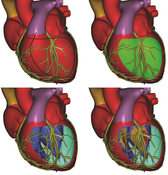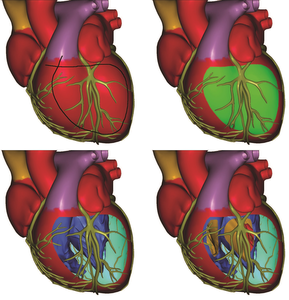Information
- Publication Type: Conference Paper
- Workgroup(s)/Project(s):
- Date: May 2017
- Publisher: Canadian Human-Computer Communications Society / Soci{\'e}t{\'e} canadienne du dialogue humain-machine
- Location: Edmonton, Alberta, CA
- Lecturer: Mohamed Radwan
- Event: Graphics Interface 2017
- DOI: 10.20380/GI2017.11
- Booktitle: Proceedings of Graphics Interface 2017
- Conference date: 17. May 2017 – 19. May 2017
- Pages: 82 – 89
Abstract
User-guided surface selection operations are straightforward for visible regions on a convex model. However, concave surfaces present a challenge because self-occlusions require multiple camera positions to get unobstructed views. Therefore, users often have to locate and switch to new unobstructed views in order to continue the operation. Our novel approach enables operations like painting or cutting in a single view, even on the backside of objects and for arbitrary depth complexity, with interactive performance. Continuous projection of a curve drawn in screen space onto the mesh guarantees seamless brush strokes or manifold cuts, unaffected by any occlusions.Our occlusion-aware surface-processing method enables a number of applications in an easy way. As examples, we show continuous painting on the surface, selecting regions for texturing, creating illustrative cutaways from nested models and animation of cutaways.
Additional Files and Images
Additional images and videos
 image:
Occlusion-aware generation of a cutaway illustration.
image:
Occlusion-aware generation of a cutaway illustration.
Additional files
Weblinks
- DOI: 10.20380/GI2017.11
BibTeX
@inproceedings{Radwan-2017-Occ,
title = "Cut and Paint: Occlusion-Aware Subset Selection for Surface
Processing",
author = "Mohamed Radwan and Stefan Ohrhallinger and Elmar Eisemann
and Michael Wimmer",
year = "2017",
abstract = "User-guided surface selection operations are straightforward
for visible regions on a convex model. However, concave
surfaces present a challenge because self-occlusions require
multiple camera positions to get unobstructed views.
Therefore, users often have to locate and switch to new
unobstructed views in order to continue the operation. Our
novel approach enables operations like painting or cutting
in a single view, even on the backside of objects and for
arbitrary depth complexity, with interactive performance.
Continuous projection of a curve drawn in screen space onto
the mesh guarantees seamless brush strokes or manifold cuts,
unaffected by any occlusions. Our occlusion-aware
surface-processing method enables a number of applications
in an easy way. As examples, we show continuous painting on
the surface, selecting regions for texturing, creating
illustrative cutaways from nested models and animation of
cutaways.",
month = may,
publisher = "Canadian Human-Computer Communications Society /
Soci{\'e}t{\'e} canadienne du dialogue humain-machine",
location = "Edmonton, Alberta, CA",
event = "Graphics Interface 2017",
doi = "10.20380/GI2017.11",
booktitle = "Proceedings of Graphics Interface 2017",
pages = "82--89",
URL = "https://www.cg.tuwien.ac.at/research/publications/2017/Radwan-2017-Occ/",
}


 paper
paper